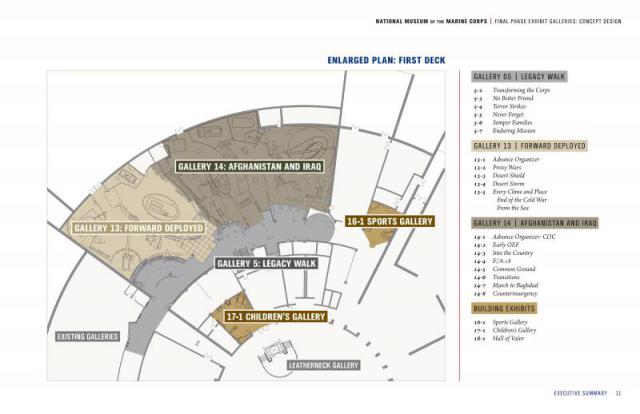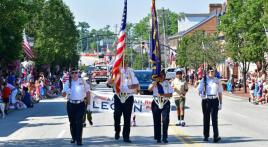Image courtesy of National Museum of the Marine Corps
From 2017 until 2020, the National Museum of the Marine Corps, located in Triangle, Va., will enter the final phase of construction to complete what was envisioned in its opening in 2006. Many new interactive galleries will open. Among them, two galleries will explore the Marines' role since 1976, including in Iraq and Afghanistan, and another will offer young children playful, hands-on learning experiences.
Groundbreaking for the additional physical space, which will double the museum's size, took place in March.
"This is actually finishing what we started out to do," said Lin Ezell, museum director.
Because of expense and scope, it was designed as a phased project, she said.
The project is a public-private partnership of the Marine Corps and the Marine Corps Heritage Foundation (MCHF), a private nonprofit. The MCHF paid for the bulk of the museum, including construction, roads, grounds and so on, Ezell said.
Potential visitors shouldn't picture cabinets of trinkets and weapons behind glass. Though cases house many of the objects, interactive galleries will immerse visitors in multiple stories around artifacts.
This is especially true of the section that tells the stories of Marines from 1976 through the present.
"For instance, we're using a Huey helicopter to tell several stories at one time. It's going to be exhibited within the context of a nighttime refueling and rearming scene in the middle of the desert. This would be in Iraq. You'll come into this scene, and you'll see quite a few Marines doing their jobs. For example, they may be loading new armament, they may be doing the refueling, the pilot may be checking things with his crew chief--so there will be several cast figures, life-like mannequins, in the scene. The light levels will be low. In the distance you may see explosions. This will be a very immersive environment with a lot going on," Ezell said.
This one exhibit with its one artifact tells stories about logistics, geography, equipment and crewmembers, Ezell said.
While some people may quibble over whether history museums should include "what's happening today," Ezell said for these exhibits, flexibility will mean this gallery "will not stand still."
"Aren't history museums supposed to talk about what's in the past? That's a tough question. To interpret history, you normally think you need some distance between you and that time period. It’s easier now to talk about what went on in World War I because you've got this long perspective. You can look back now and see the ramifications of the war. With something that's still ongoing, you don't have that historical perspective," Ezell said. "The best you can do is be more of a reporter and less of a historian when you tell that story because our views of what's important may change with time and perspective."
This exhibit is also likely to change as artifacts from this era are donated, Ezell said.
"But it's important because those young men and women who are fighting that war in Afghanistan still and Iraq still. They're dying. They're giving their all to the effort and what they do should be honored in their museum," Ezell said.
Another section, quite different, that also relies on immersion will be the children's gallery, geared toward kids in grade school, preschoolers and toddlers.
Ezell said over 50,000 students toured the museum in 2014, which was anticipated. But there was also a surprising number of young children coming through the doors.
"There are many inter-generational visitors. Granddad is there with his son and his grandchildren, for example. We didn't have anything in the original galleries that spoke to children, so we've had to rethink who our audience is," she said.
The children's gallery will give a sense of the history of the Marines and some basic geography through play.
"There will be a colonial war tavern that will represent Tun Tavern in Philadelphia where the first Marines were signed up. Back then of course, taverns were like hotels. You'll actually be able to go inside that colonial structure and see a quill pin and see how they were signed up. There will be a WWI trench, a WWII ground vehicle that you can get into and then a helicopter that represents Korea and Vietnam, then uniforms and other gear to try on and get your hands on that represent Marines today," Ezell said. "In the center of all this is a big globe because Marines operate in every clime and place. So it's the perfect place to introduce geography to little ones."
Ezell said of all the upcoming exhibits as the museum nears completion, she is most excited about the "treatment of 9/11."
"I think it's very important that no one forget the horrors of that day and what that day meant for Marines and Americans for the next several years as we reacted to 9/11 in Afghanistan and Iraq," she said.
She is also carefully watching a "theater-like niche" tentatively titled "Never Forget," which honors those Marines killed in action.
"For four years in a row there will be new things for visitors to come back and see," Ezell said.
Those "new things" include:
2017
-"Giant-screen theater"
-Children's gallery
-Hall of Valor, which will memorialize Medal of Honor and Silver Star recipients
-Combat art gallery with an attached studio
2018
-Two new galleries that cover the history of the Marine Corps from 1976 through the wars in Iraq and Afghanistan
2019
-Sports gallery, which includes a Hall of Fame
2020
-Changing gallery
-Gallery that discusses the years between the World Wars (converted from what is now a classroom)
To check on opening dates for specific displays, visit the National Museum of the Marine Corps website: www.usmcmuseum.org




